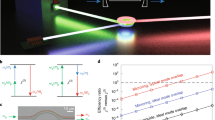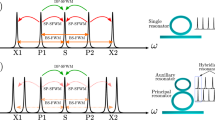Abstract
Optical frequency conversion has applications ranging from tunable light sources to telecommunications-band interfaces for quantum information science. Here, we demonstrate efficient, low-noise frequency conversion on a nanophotonic chip through four-wave-mixing Bragg scattering in compact (footprint <0.5 × 10–4 cm2) Si3N4 microring resonators. We investigate three frequency conversion configurations: spectral translation over a few nanometres within the 980 nm band; upconversion from 1,550 nm to 980 nm; and downconversion from 980 nm to 1,550 nm. With conversion efficiencies ranging from 25% for the first process to >60% for the last two processes, a signal conversion bandwidth of >1 GHz, a required continuous-wave pump power of <60 mW and background noise levels between a few femtowatts and a few picowatts, these devices are suitable for quantum frequency conversion of single-photon states from InAs/GaAs quantum dots. Simulations based on coupled mode equations and the Lugiato–Lefever equation are used to model device performance, and show quantitative agreement with measurements.
This is a preview of subscription content, access via your institution
Access options
Subscribe to this journal
Receive 12 print issues and online access
$209.00 per year
only $17.42 per issue
Buy this article
- Purchase on Springer Link
- Instant access to full article PDF
Prices may be subject to local taxes which are calculated during checkout






Similar content being viewed by others
References
Boyd, R. W. Nonlinear Optics (Academic, 2003).
Agrawal, G. P. Nonlinear Fiber Optics (Academic, 2007).
Langrock, C. et al. Highly efficient single-photon detection at communication wavelengths by use of upconversion in reverse-proton-exchanged periodically poled linbo3 waveguides. Opt. Lett. 30, 1725–1727 (2005).
Gnauck, A. H., Jopson, R., McKinstrie, C., Centanni, J. & Radic, S. Demonstration of low-noise frequency conversion by Bragg scattering in a fiber. Opt. Express 14, 8989–8994 (2006).
Kumar, P. Quantum frequency-conversion. Opt. Lett. 15, 1476–1478 (1990).
Raymer, M. G. & Srinivasan, K. Manipulating the color and shape of single photons. Phys. Today 65, 32–37 (November 2012).
Moss, D. J., Morandotti, R., Gaeta, A. L. & Lipson, M. New CMOS-compatible platforms based on silicon nitride and hydex for nonlinear optics. Nature Photon. 7, 597–607 (2013).
Foster, M. A. et al. Broad-band optical parametric gain on a silicon photonic chip. Nature 441, 960–963 (2006).
Del'Haye, P. et al. Optical frequency comb generation from a monolithic microresonator. Nature 450, 1214–1217 (2007).
Turner, A. C., Foster, M. A., Gaeta, A. L. & Lipson, M. Ultra-low power parametric frequency conversion in a silicon microring resonator. Opt. Express 16, 4881–4887 (2008).
Levy, J. S. et al. CMOS-compatible multiple-wavelength oscillator for on-chip optical interconnects. Nature Photon. 4, 37–40 (2010).
Razzari, L. et al. CMOS-compatible integrated optical hyper-parametric oscillator. Nature Photon. 4, 41–45 (2010).
Liu, X., Osgood, R. M., Vlasov, Y. A. & Green, W. M. Mid-infrared optical parametric amplifier using silicon nanophotonic waveguides. Nature Photon. 4, 557–560 (2010).
Zlatanovic, S. et al. Mid-infrared wavelength conversion in silicon waveguides using ultracompact telecom-band-derived pump source. Nature Photon. 4, 561–564 (2010).
McKinstrie, C., Yu, M., Raymer, M. & Radic, S. Quantum noise properties of parametric processes. Opt. Express 13, 4986–5012 (2005).
Marhic, M. E., Yang, F., Kazovsky, L. & Park, Y. Widely tunable spectrum translation and wavelength exchange by four-wave mixing in optical fibers. Opt. Lett. 21, 1906–1908 (1996).
Uesaka, K., Kin-Yip, K., Marhic, M. E. & Kazovsky, L. Wavelength exchange in a highly nonlinear dispersion-shifted fiber: theory and experiments. IEEE J. Sel. Top. Quantum Electron. 8, 560–568 (2002).
McKinstrie, C., Harvey, J., Radic, S. & Raymer, M. Translation of quantum states by four-wave mixing in fibers. Opt. Express 13, 9131–9142 (2005).
Lefrancois, S., Clark, A. S. & Eggleton, B. J. Optimizing optical Bragg scattering for single-photon frequency conversion. Phys. Rev. A 91, 013837 (2015).
Agha, I., Davanço, M., Thurston, B. & Srinivasan, K. Low-noise chip-based frequency conversion by four-wave-mixing Bragg scattering in sin x waveguides. Opt. Lett. 37, 2997–2999 (2012).
Agha, I., Ates, S., Davanço, M. & Srinivasan, K. A chip-scale, telecommunications-band frequency conversion interface for quantum emitters. Opt. Express 21, 21628–21638 (2013).
Huang, Y., Velev, V. & Kumar, P. Quantum frequency conversion in nonlinear microcavities. Opt. Lett. 38, 2119–2121 (2013).
Lin, Z., Johnson, S. G., Rodriguez, A. W. & Loncar, M. Design of diamond microcavities for single photon frequency down-conversion. Opt. Express 23, 25279–25294 (2015).
Ates, S. et al. Two-photon interference using background-free quantum frequency conversion of single photons emitted by an InAs quantum dot. Phys. Rev. Lett. 109, 147405 (2012).
McGuinness, H. J., Raymer, M. G., McKinstrie, C. J. & Radic, S. Quantum frequency translation of single-photon states in a photonic crystal fiber. Phys. Rev. Lett. 105, 093604 (2010).
Clark, A. S., Shahnia, S., Collins, M. J., Xiong, C. & Eggleton, B. J. High-efficiency frequency conversion in the single-photon regime. Opt. Lett. 38, 947–949 (2013).
Ferdous, F. et al. Spectral line-by-line pulse shaping of on-chip microresonator frequency combs. Nature Photon. 5, 770–776 (2011).
Brasch, V. et al. Photonic chip-based optical frequency comb using soliton Cherenkov radiation. Science 351, 357–360 (2016).
Chin, M. & Ho, S. Design and modeling of waveguide-coupled single-mode microring resonators. J. Lightw. Technol. 16, 1433–1446 (1998).
Shah Hosseini, E., Yegnanarayanan, S., Atabaki, A. H., Soltani, M. & Adibi, A. Systematic design and fabrication of high-Q single-mode pulley-coupled planar silicon nitride microdisk resonators at visible wavelengths. Opt. Express 18, 2127–2136 (2010).
Spencer, D. T., Bauters, J. F., Heck, M. J. & Bowers, J. E. Integrated waveguide coupled Si3N4 resonators in the ultrahigh-Q regime. Optica 1, 153–157 (2014).
Carmon, T., Yang, L. & Vahala, K. Dynamical thermal behavior and thermal self-stability of microcavities. Opt. Express 12, 4742–4750 (2004).
Coen, S., Randle, H. G., Sylvestre, T. & Erkintalo, M. Modeling of octave-spanning Kerr frequency combs using a generalized mean-field Lugiato–Lefever model. Opt. Lett. 38, 37–39 (2013).
Hansson, T. & Wabnitz, S. Bichromatically pumped microresonator frequency combs. Phys. Rev. A 90, 013811 (2014).
Matsko, A. B., Savchenkov, A. A., Strekalov, D., Ilchenko, V. S. & Maleki, L. Optical hyperparametric oscillations in a whispering-gallery-mode resonator: threshold and phase diffusion. Phys. Rev. A 71, 033804 (2005).
Chembo, Y. K. & Yu, N. Modal expansion approach to optical-frequency-comb generation with monolithic whispering-gallery-mode resonators. Phys. Rev. A 82, 033801 (2010).
Hansson, T., Modotto, D. & Wabnitz, S. On the numerical simulation of Kerr frequency combs using coupled mode equations. Opt. Commun. 312, 134–136 (2013).
Chembo, Y. K. & Menyuk, C. R. Spatiotemporal Lugiato–Lefever formalism for Kerr-comb generation in whispering-gallery-mode resonators. Phys. Rev. A 87, 053852 (2013).
Michler, P. Single Semiconductor Quantum Dots (Springer, 2009).
Ates, S. et al. Improving the performance of bright quantum dot single photon sources using temporal filtering via amplitude modulation. Sci. Rep. 3, 1397 (2013).
Dutt, A. et al. On-chip optical squeezing. Phys. Rev. Appl. 3, 044005 (2015).
Ramelow, S. et al. Silicon-nitride platform for narrowband entangled photon generation. Preprint at http://arXiv:1508.04358 (2015).
Reimer, C. et al. Cross-polarized photon-pair generation and bi-chromatically pumped optical parametric oscillation on a chip. Nature Commun. 6, 8236 (2015).
Dong, C., Fiore, V., Kuzyk, M. C. & Wang, H. Optomechanical dark mode. Science 338, 1609–1613 (2012).
Hill, J. T., Safavi-Naeini, A. H., Chan, J. & Painter, O. Coherent optical wavelength conversion via cavity optomechanics. Nature Commun. 3, 1196 (2012).
Liu, Y., Davanço, M., Aksyuk, V. & Srinivasan, K. Electromagnetically induced transparency and wideband wavelength conversion in silicon nitride microdisk optomechanical resonators. Phys. Rev. Lett. 110, 223603 (2013).
Bader, M., Heugel, S., Chekhov, A. L., Sondermann, M. & Leuchs, G. Efficient coupling to an optical resonator by exploiting time-reversal symmetry. New J. Phys. 15, 123008 (2013).
Liu, C. et al. Efficiently loading a single photon into a single-sided Fabry–Perot cavity. Phys. Rev. Lett. 113, 133601 (2014).
Acknowledgements
Q.L. acknowledges support under the Cooperative Research Agreement between the University of Maryland and NIST-CNST (award no. 70NANB10H193). The authors thank J. Liu for help with using the grating spectrometer for the noise measurement, L. Van Der Vegt from Yenista Optics for the loan of a 1,550 nm tunable filter and S. Papp from NIST Boulder for comments.
Author information
Authors and Affiliations
Contributions
Q.L. led the design, fabrication and measurement, with assistance from M.D. and K.S. Q.L. and K.S. wrote the manuscript and K.S. supervised the project.
Corresponding authors
Ethics declarations
Competing interests
The authors declare no competing financial interests.
Supplementary information
Supplementary information
Supplementary information (PDF 2619 kb)
Rights and permissions
About this article
Cite this article
Li, Q., Davanço, M. & Srinivasan, K. Efficient and low-noise single-photon-level frequency conversion interfaces using silicon nanophotonics. Nature Photon 10, 406–414 (2016). https://doi.org/10.1038/nphoton.2016.64
Received:
Accepted:
Published:
Issue Date:
DOI: https://doi.org/10.1038/nphoton.2016.64
This article is cited by
-
A wideband, high-resolution vector spectrum analyzer for integrated photonics
Light: Science & Applications (2024)
-
Wavelength-accurate nonlinear conversion through wavenumber selectivity in photonic crystal resonators
Nature Photonics (2024)
-
Indistinguishable telecom band photons from a single Er ion in the solid state
Nature (2023)
-
Telecom-band quantum dot technologies for long-distance quantum networks
Nature Nanotechnology (2023)
-
Recent advances in laser self-injection locking to high-Q microresonators
Frontiers of Physics (2023)



